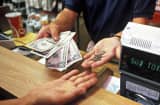
U.S. consumer spending rose for a second straight month in May on increased demand for automobiles and other goods, but there are fears Britain’s vote to leave the European Union could hurt confidence and prompt households to cut back on consumption.
The Commerce Department said on Wednesday consumer spending, which accounts for more than two-thirds of U.S. economic activity, increased 0.4 percent last month, pointing to an acceleration in economic growth in the second quarter.
Consumer spending in April was revised up to show it advancing 1.1 percent instead of the previously reported 1.0 percent jump. Last month’s increase in consumer spending was in line with economists’ expectations.
Last Thursday’s so-called “Brexit” referendum wiped off an estimated $3.01 trillion from global stock markets over two days. Economists say if the financial turbulence persists, that could hurt consumer confidence and cause companies to either delay or scale back capital projects, exerting further downward pressure on business investment.
So far, economists are forecasting that Brexit will subtract an average of two-tenths of a percentage point from U.S. growth over the next six quarters.
When adjusted for inflation, consumer spending rose 0.3 percent after gaining 0.8 percent in April. That could prompt economists to raise their forecasts for second-quarter consumer spending and economic growth.
Consumer spending rose at a 1.5 percent annual rate in the first quarter, holding down gross domestic product growth to a 1.1 percent pace. The Atlanta Federal Reserve is currently estimating second-quarter GDP rising at a 2.6 percent rate.
Despite the steady gains in consumer spending last month, inflation remained benign. The personal consumption expenditures (PCE) price index, excluding the volatile food and energy components, rose 0.2 percent last month after a similar gain in April.
In the 12 months through May the core PCE increased 1.6 percent after rising by the same margin in April. The core PCE is the Federal Reserve’s preferred inflation measure and is running below the U.S. central bank’s 2 percent target.
Last month, consumer spending was boosted by a 0.3 percent jump in purchases of long-lasting manufactured goods such as automobiles. Spending on services increased 0.4 percent.
Personal income rose 0.2 percent after advancing 0.5 percent in April. Wages and salaries gained 0.2 percent. Savings slipped to $730.6 billion last month from $753.7 billion in April.



